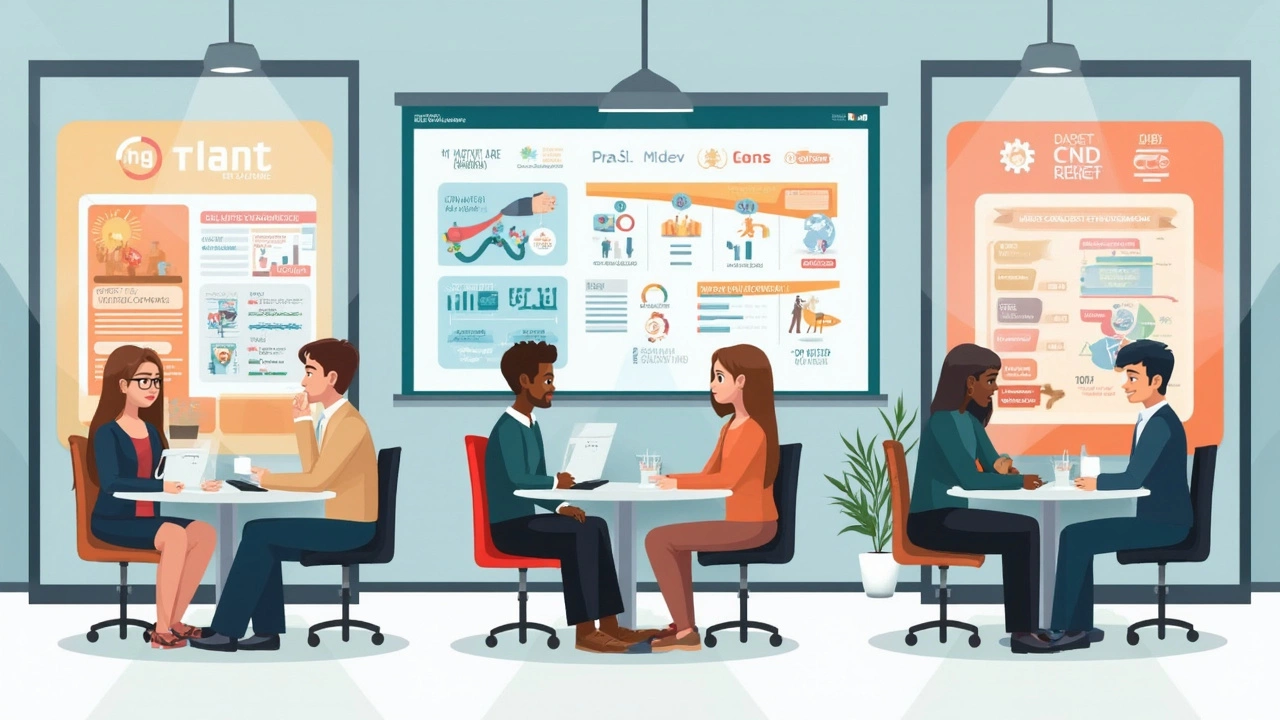Imagine staring at your banking app and watching the numbers slip deeper into the red every month. No matter how much you scrimp or how many nights you skip takeout, the debt just won’t budge. Sound familiar? You’re not alone. In Ireland, and across much of Europe and North America, household debt has climbed to new peaks. Banks keep hiking interest rates, and more people have started googling “debt relief” than ever before. But when it comes to picking the right debt solution, it’s like wading through a swamp of confusing terms, glossy promises, and way too many forms. So, what’s the best debt relief program for 2025? Let’s get real and figure that out together.
How Debt Relief Programs Work—and Who They’re For
Debt relief means different things to different people. To some, it’s a fresh start. To others, it feels like a last resort before things get messier. At its heart, a debt relief program is any plan—run by a company, charity, or government—that helps you pay off what you owe more manageably. There’s more than one flavor, and what works for someone in Dublin with a single fat credit card bill won’t always solve things for someone in Leitrim facing overdue mortgage payments and a dodgy payday loan.
There are a few main buckets: debt management plans (DMPs), debt consolidation loans, debt settlement, and bankruptcy or insolvency options like the Personal Insolvency Arrangement (PIA) popular here in Ireland. Each program has its own vibe, requirements, and risks.
Debt management plans usually get you into a steady, fixed payment—no surprise bills each month. They work best for folks with steady income who just need help squashing high interest rates and keeping all their creditors happy. Debt consolidation takes all your little debts (think: credit cards, personal loans, lingering overdrafts) and rolls them into one big loan—typically with a single, lower interest rate. This is great if you qualify for that better rate, but watch for hidden fees.
For people whose situation’s gotten out of hand, debt settlement can sound super appealing—negotiators try to get your creditors to accept less than the full amount owed. Huge warning: this trashes your credit score for years, and there’s no guarantee creditors will say yes. Last is insolvency and bankruptcy. Ireland’s Personal Insolvency Arrangement and Debt Relief Notice (DRN) are legal proceedings to protect you from creditors, but they come with long-term effects—like being flagged on databases your landlord or a future employer might check.
Debt relief isn’t just for people in salary jobs with perfect paperwork. You can qualify even if you’ve had income losses, a shaky credit history, or your bills come from unexpected emergencies like medical issues or layoffs. In fact, according to the Irish Central Bank, 1 in 6 mortgage holders has sought some kind of debt mediation post-pandemic. So if you’re haunted by bills, you’ve got company.
It's super important to match your situation to the right program—don’t let glossy ads sway you into the wrong fix. Consider things like your employment, whether you own your house, if you’re behind on taxes, or if you expect your income to bounce back. For example, most DMPs won’t help much with tax or student loan debts, and bankruptcy triggers some harsh restrictions on business owners.
The Most Popular Debt Relief Options in 2025
So, what’s on the table this year? While “debt relief” is often slapped on every ad from loan sharks to charities, the main options have evolved as the economy’s changed. Here’s the current menu.
- Debt Management Plan (DMP): Offered by credit counseling agencies or charities like MABS in Ireland, these get your creditors to agree to lower interest and freeze fees for as long as you make set payments. There’s no loan or risky juggling; just one payment split among all your lenders each month. Success rates hover around 70% for folks who stick with them.
- Debt Consolidation Loans: If you managed not to damage your credit too much, consolidation loans can rescue you from juggling too many payments, rolling debt into one (hopefully lower-interest) package. EU law now requires lenders to show you the real cost up front, so look for the “Annual Percentage Rate (APR)” on paperwork. Watch out: If your new loan lasts longer, you might end up paying more interest in the end.
- Debt Settlement: This is when you (or a service working for you) try to convince the people you owe money to accept less. The catch? It damages your credit rating, there are sometimes up-front fees, and there’s tax on any forgiven debt. The success rate can be as low as 40%—not great odds, but for some it’s a last shot before insolvency.
- Insolvency or Bankruptcy (PIA/DRN/Bankruptcy): Not just for big corporations. If you owe more than €20,000 and can’t pay, the Personal Insolvency Arrangement might let you keep your home. Bankruptcy wipes the slate clean but has big life restrictions for up to 3 years.
One thing that’s grown more popular since the 2020s is online-based debt counselors. They promise anonymity and convenience but be careful—always double-check if they’re registered with the Central Bank, Financial Conduct Authority, or local watchdog. The last thing you need is to pay a scammer upfront and get ghosted. Check out this quickie table showing some rough comparisons of program features.
| Program Type | Credit Impact | Average Time (Months) | Success Rate | Main Pro | Main Con |
|---|---|---|---|---|---|
| DMP | Low/Short-term | 24-60 | 70% | Simplifies payments | No help for tax/student debt |
| Consolidation Loan | Low if paid | 24-84 | 60% | Lower interest, single payment | Needs fair credit |
| Settlement | High/Long-term | 12-36 | 40% | Reduce amount owed | Damages credit |
| PIA/DRN/Bankruptcy | High/Years | 36-60 | 80% (for PIA) | Legal protection | Restricts future borrowing |
It’s wild how different these paths look on paper versus real life. Some people save thousands, others end up with a credit score in tatters or locked out of the rental market. So, how do you know which to trust?

Red Flags to Watch—And How to Pick the Best
With debt piling up, it’s tempting to jump at the first relief offer you see. But not every program is the hero it claims to be. In Ireland and the UK, unauthorised firms are an actual epidemic—last year, the Central Bank warned about 80 fake “debt specialists” running online ads. Always make sure the provider is registered, has a physical office or traceable online history, and check their reputation on forums or social media. A legitimate agency will never demand all their fees up-front.
If an offer sounds too good—like wiping out half your debt and telling you it “won’t affect your credit”—run the other way. Real programs always involve some sacrifice. Any agency that guarantees results can’t be trusted. Instead, ask them clear questions: What’s the monthly cost? How long is the program? Will my info stay private? Will I go to court? You want detailed, straightforward answers.
It’s also essential to ask who the service actually helps. Some programs only work for unsecured debts like credit cards or old phone bills. Got a tax bill, student loan, or mortgage arrears? Make sure the plan will touch those. Try to get a written assessment before committing. Good agencies (think: MABS, StepChange in the UK, or reputable local credit unions) will often provide a free, no-strings consultation.
Another tip—check if the agency files your payment records with credit bureaus. If you’re on a DMP, late or partial payments can ding your credit even if you’re “in the program.” It’s much better to set up automatic payments from your bank so there’s no risk of forgetting. Also, keep track of every statement; if something looks off, flag it quickly so errors don’t wreck your progress.
The Personal Insolvency Arrangement (PIA) in Ireland deserves its own mention. It was created after the financial crash, and since then over 7,000 people have used it. The big perk is protection from repossession—if you’re behind on mortgage payments, PIA is often your best safety net. But you need to work with a licensed Personal Insolvency Practitioner (PIP), and the process is not speedy—six to nine months, on average. Still, it beats losing your house to a vulture fund.
Tangible Steps: Getting Started—and Sticking With It
So, you’re sold on the idea of debt relief but not sure where to begin. Here’s a breakdown of steps that will get you moving—and keep you motivated all the way through.
- Start by pulling together everything you owe—credit cards, loans, overdue utility bills, medical debts, the lot. List balances, minimum payments, interest rates, and which are secured (e.g., car, house) or unsecured (cards, catalogues).
- Check your most recent credit report (in Ireland, that’s the Central Credit Register, or the Irish Credit Bureau database if you access it before it gets phased out). This isn’t just about seeing your score but double-checking what’s listed and making corrections if something’s wrong.
- Browse local and national agencies for free guidance. MABS, for example, offers confidential consultations. There’s no shame in asking for help; those staff see it all the time and will never judge.
- Calculate your realistic monthly budget by tracking income and unavoidable expenses. If you can squeeze out even €50 a month, that’s a starting point. Honest numbers beat wishful thinking every time.
- Speak to a debt adviser. They’ll help you weigh your options based on your goals—maybe you want to save your credit, or maybe you just want the stress to stop, even if you need to hit “reset.”
- Before you sign up for any program, demand a side-by-side breakdown of costs—including hidden fees and whether there’s a risk you’ll owe tax on forgiven debts. This is where those numbers from real life stories or reviews come in handy. Ask in local Facebook groups if anyone’s had experience with the company.
- Once you’ve picked a plan, commit all the way. Automate payments. Cut up or freeze cards linked to the debts (seriously—stick them in the freezer if you need to). And set a monthly check-in reminder to track progress and catch any errors early.
- If things change—say your income goes up or down—tell your adviser right away. Programs can be adjusted, but ghosting your agency or missing payments is what kills success rates.
- Celebrate little wins! Every time a debt drops off the list, give yourself some credit. Most people in debt relief burn out from boredom, not difficulty. Acknowledge your progress—even if it’s slow.
The key is facing the full mess, not hiding from it. Debt rarely fixes itself, but it doesn’t have to be a life sentence either.

Real Stories and Stats: Does Debt Relief Actually Work?
Every big promise online is supposedly “proven” but reality is often less dramatic. So let’s look at some genuine stats and lived experiences. According to MABS, over 30,000 Irish households have used their mediation services in the past five years. Their own studies say around 65% of people who finish a debt management plan become debt free within six years—though that means sticking it out even when things get tough.
Debt consolidation loans are a mixed bag. When used by disciplined borrowers who stop using credit cards, they offer a way out with single-digit interest rates, but if you start racking up new balances, you’ll be worse off than ever. A friend of mine in Galway used a consolidation loan in 2023 and shaved two years off her repayment timeline, but only because she locked her old cards away and lived off a no-frills budget for a while.
You’ll see “debt settlement” success stories pop up online, but this road is not for the faint-hearted. A study from the UK’s FCA found nearly half of settlement users dropped out midway—either discouraged, or because creditors refused to play ball. And remember: settled or cancelled debt is often reported to tax offices as “income,” so come January, people sometimes get hit with a surprise tax bill. Ouch.
Personal Insolvency Arrangements have their fair share of hassle, but they save hundreds of homes from forced sale each year according to Ireland’s Insolvency Service. You’ll spend months in paperwork hell, but it does throw a legal shield over your home as long as you keep up new terms. The downside? Your credit will be stained for years, and if you plan to move abroad, some agreements might fall apart.
What makes the difference? Hands down, people who work with honest advisers, keep up with reviews, and aren’t afraid to call out mistakes—these are the ones who shine. Debt relief is never a magic trick, but it’s one of the few lifelines that actually stands up under scrutiny when times are tough.
So if you’re facing the stress of calls, letters, or scary emails, you’re not doomed—and you’re not a mess. You just need a plan that matches your reality. Do your homework, choose a reputable route, and don’t get taken in by wild promises. The best debt relief program isn’t the slickest ad or the fastest fix; it’s the one you can stick with until you’re free.
